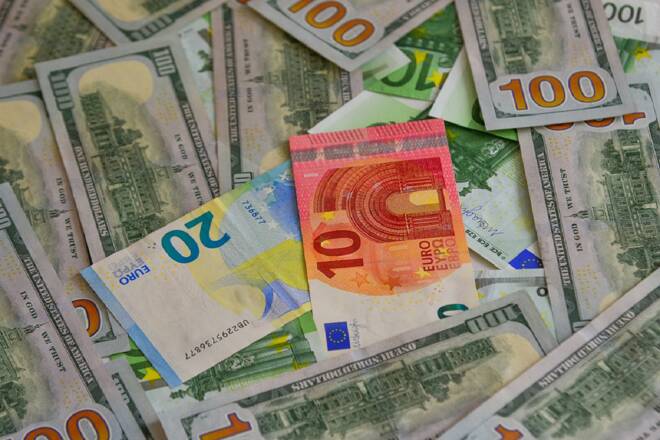Advertisement
Advertisement
EUR/USD: Debt Ceiling Agreement Boosts Dollar, While Euro Faces Uncertainty
By:
US debt ceiling agreement provides temporary relief, but inflation along with Fed and ECB rate hike concerns influence EUR/USD dynamics.
HoweHighlights
- Euro weakens due to low trading activity.
- Debt ceiling agreement supports the U.S. Dollar.
- Market concerns persist amidst inflation and potential Fed rate hikes.
Overview
The Euro is slightly lower against the U.S. Dollar on Monday, mostly due to low trading activity. However, the greenback is being supported because of optimism about a debt ceiling agreement reached over the weekend. The markets in the United States and the United Kingdom are closed today for public holidays.
As of 11:20 GMT, the EUR/USD is at 1.0717, down 0.0006 or 0.05%. On Friday, the Invesco CurrencyShares Euro Trust ETF (FXE) settled at $99.10, up $0.11 or 0.11%.
Debt Ceiling Deal Reached: Temporary Relief
On Saturday, U.S. President Joe Biden and top congressional Republican Kevin McCarthy reached a tentative agreement to raise the U.S. federal government’s debt ceiling, which is currently at $31.4 trillion. This agreement aims to prevent the U.S. from defaulting on its debt. However, it is expected to provide only temporary relief to the markets, as concerns about inflation and potential interest rate hikes persist.
Debt Concerns Impact Dollar’s Strength
In other news, the narrowing of U.S. credit default swaps (CDS) over the short term indicates reduced concerns about a U.S. debt default, which could strengthen the U.S. Dollar and exert downward pressure on the EUR/USD.
On the other hand, the rise in five-year swap rates suggests some caution in the market regarding the debt ceiling deal, which might weaken the U.S. Dollar and have a modest positive impact on the EUR/USD.
If the debt ceiling deal passes, market attention is likely to shift to the U.S. Federal Reserve’s rate plans. Any indications of higher interest rates in the future can strengthen the U.S. Dollar and potentially lower the EUR/USD.
Furthermore, the resilient growth and persistent inflation in the U.S. could raise expectations of tighter monetary policy, favoring the U.S. Dollar and potentially weakening the EUR/USD.
Fed Rate Hike Anticipation Impacts EUR/USD
Anticipation of a potential rate hike by the Federal Reserve can also strengthen the U.S. Dollar and potentially impact the EUR/USD. Additionally, the lower Eurozone government bond yields might reduce the attractiveness of the Euro as an investment, potentially leading to a weaker EUR/USD.
Technical Analysis
The EUR/USD continues to trade on the weakside of 1.0834 (S1), putting it in a bearish position. This level is new resistance.
However, if sellers continue to emerge and there is an acceleration to the downside then look for the move to possibly extend into 1.0657 (S2).
Overcoming and sustaining a rally over 1.0834 (S1) will signal the return of buyers. This could generate the upside momentum needed to retest the PIVOT at 1.0965 over the near-term.
| S1 – 1.0834 | R1 – 1.1141 |
| S2 – 1.0657 | R2 – 1.1272 |
| S3 – 1.0527 | R3 – 1.1449 |
For a look at all of today’s economic events, check out our economic calendar.
About the Author
James Hyerczykauthor
James Hyerczyk is a U.S. based seasoned technical analyst and educator with over 40 years of experience in market analysis and trading, specializing in chart patterns and price movement. He is the author of two books on technical analysis and has a background in both futures and stock markets.
Advertisement
